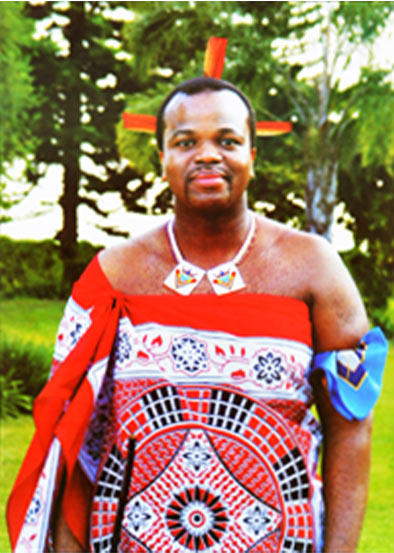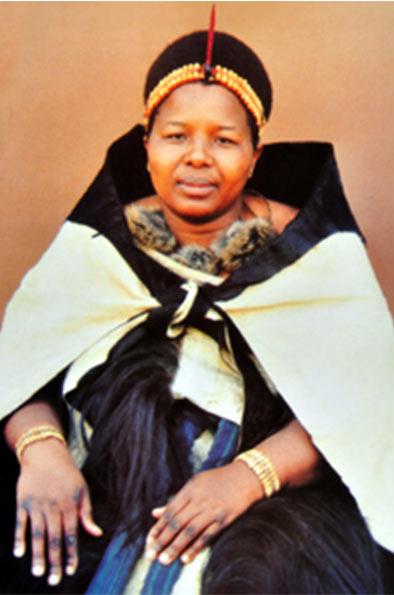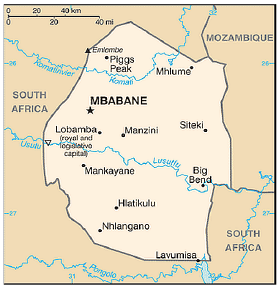BRIEF ABOUT THE KINGDOM
Who are we?
The king in the Swazi setting rules together with a Queen Mother who is supposed to be a biological mother to that king.

HIS MAJESTY KING MSWATI III.
His Majesty King Mswati III was born at the Raleigh Fitkin Memorial Hospital in Manzini, Eswatini, on 19th April, 1968, that is a few months before Eswatini attained independence from Britain. At birth, he was named Makhosetive (“King of All Nations”). Prince Makhosetive was educated at Masundvwini Palace School and later went to Sherborne School in the United Kingdom until 1986 when he returned to Eswatini to be installed King of Eswatini. According to tradition, his official name and title became Mswati III.
Prince Makhosetive was introduced to the Emaswati nation and the whole world at large as the Crown Prince in September 1983 and was crowned King of Eswatini on 25 April, 1986, at the age of 18, making him the youngest ruling Monarch in the world. The King and the Queen Mother (Indlovukazi), rule jointly.
His Majesty King Mswati III holds the dual titles of King and Ingwenyama as these roles reflect both his political authority and his cultural significance as the leader of Eswatini.
His Majesty King Mswati III was born at the Raleigh Fitkin Memorial Hospital in Manzini, Eswatini, on 19th April, 1968, that is a few months before Eswatini attained independence from Britain. At birth, he was named Makhosetive (“King of All Nations”). Prince Makhosetive was educated at Masundvwini Palace School and later went to Sherborne School in the United Kingdom until 1986 when he returned to Eswatini to be installed King of Eswatini. According to tradition, his official name and title became Mswati III.
Prince Makhosetive was introduced to the Emaswati nation and the whole world at large as the Crown Prince in September 1983 and was crowned King of Eswatini on 25 April, 1986, at the age of 18, making him the youngest ruling Monarch in the world. The King and the Queen Mother (Indlovukazi), rule jointly.
His Majesty King Mswati III holds the dual titles of King and Ingwenyama as these roles reflect both his political authority and his cultural significance as the leader of Eswatini.
- King (Political Role):
- The title of King denotes his role as the head of state and government.In this capacity, His Majesty the King represents Eswatini on the international stage and exercises authority in the nation’s governance.
- Ingwenyama (Cultural Role):
- Ingwenyama, meaning “The Lion,” is a traditional title deeply rooted in Swazi culture. It symbolizes strength, unity, and leadership.
- As Ingwenyama, he is seen as the spiritual and cultural custodian of the Swazi people, upholding traditions and presiding over important ceremonies like the Umhlanga Reed Dance and Incwala (the Kingship Ceremony).
HER MAJESTY THE QUEEN MOTHER AND INDLOVUKAZI
In accordance with Emaswati law and Custom and the Constitution, until a king is installed and has publicly assumed the functions and responsibilities of a king, or during any period when, by reason of absence from Eswatini, or any other cause, unable to perform the functions of his office, those functions are performed by the Queen Mother, acting as Queen Regent.

Location
- The Kingdom of Eswatini (formerly known as Swaziland) is located in sub-Saharan Africa, in the Southern African Region
- Eswatini is one of 44 landlocked developing countries (LLDCs) in the world, ‘locked’ by the Republic of South Africa (approximately 430 km – north, west, south, and south-east) and Mozambique (approximately 105 km – north-east).
- Eswatini is the 43rd smallest country in the world, occupying 17,364 square kilometers (approximately 6,703 square miles).
Population, Ethnicity, and Language
- The estimated population size of Eswatini stands at 1.2 million.
- It is basically ethnic Emaswati, notwithstanding, there is a small percentage of populations from other African countries, Europe, the USA, Asia and the rest of the world
- The native and prevalent language is siSwati, spoken throughout the Kingdom. The official working languages are both English and siSwati; they are taught in schools and used as official languages for conducting official business, in public offices and social gatherings.
The Government system and Arms of Government
The Tinkhundla System of Governance
The Kingdom of Eswatini practices the Tinkhundla (community centers or constituencies) system of governance, a monarchial form of democracy established to facilitate and encourage decentralization and promotion of proportional bottom-up development and service delivery.
“Tinkhundla” are constituencies designed to ensure equality of participation in all national activities, and more importantly, during national Parliamentary elections where each constituency nominate and vote for their desired candidates straight to parliament.
The Tinkhundla system also advocates and promotes open and collective consultation and dialogue on issues of national importance, of all Emaswati, irrespective of educational and economic background and social status. The importance of this approach cannot be overemphasized because many of these issues end up providing policy direction of various sectors of the Eswatini economy.
The Arms of Government
The current edition of the Constitution as adopted in 2005, is the supreme law of Eswatini. It provides for three arms of Government namely:
- The Executive – Cabinet Ministers
- The Legislature – A bicameral chamber comprising the House of Assembly and the House of Senate
- The Judicial – The Supreme Courts, the High Court, the Magistrate Courts, Industrial Court and the Industrial Court of Appeal (is confined to Labour disputes) as well as other specialized courts, such as Customary Courts.
Faiths and Religion
About 90% of Eswatini’s population follows the Christian faith, as such, the Kingdom is a Christian country. Be that as it may, Eswatini upholds the belief of freedom of worship. To that end, other religions are free to practice their faiths and currently the other 10% of the population practice Islam, Bahai, and indigenous African beliefs, among others.
Climate – Seasons and Topography
Notwithstanding the effects and impact of climate change, the Eswatini climate is characterized by hot and wet summers ranging from October to March; and cold and dry winters from April to September.
The Kingdom is generally mountainous with moderately sloppy plains and a large proportion of flat arable land for agriculture.
For daily weather conditions, please visit the link : http://www.swazimet.gov.sz.
Currency
- The Lilangeni (singular) and Emalangeni (plural) is the Eswatini currency.
- The Lilangeni is currently pegged to the South African Rand at: 1 Lilangeni (SZL) = 1 South African Rands (ZAR).


